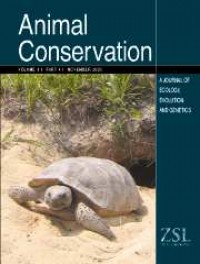
ISSN: 1367-9430
Journal Home
Journal Guideline
Animal Conservation Q1 Unclaimed
Animal Conservation is a journal indexed in SJR in Ecology and Nature and Landscape Conservation with an H index of 101. It has a price of 3000 €. It has an SJR impact factor of 1,036 and it has a best quartile of Q1. It is published in English. It has an SJR impact factor of 1,036.
Animal Conservation focuses its scope in these topics and keywords: groups, annex, attributes, back, bottlenecks, bycatch, cervinae, cervus, combining, connectivity, ...
Type: Journal
Type of Copyright:
Languages: English
Open Access Policy: Open Choice
Type of publications:
Publication frecuency: -


3000 €
Inmediate OANPD
Embargoed OA0 €
Non OAMetrics
1,036
SJR Impact factor101
H Index109
Total Docs (Last Year)254
Total Docs (3 years)7742
Total Refs753
Total Cites (3 years)223
Citable Docs (3 years)2.58
Cites/Doc (2 years)71.03
Ref/DocOther journals with similar parameters
Nature Sustainability Q1
Fungal Diversity Q1
Genome Biology Q1
Human Reproduction Update Q1
Annual Review of Ecology, Evolution, and Systematics Q1
Compare this journals
Aims and Scope
Best articles by citations
A social network approach to detect parallel wildlife trafficking: a novel tool, with potential limitations in a closed, specialist system
View moreConsidering the temporal when managing the spatial: a population range expansion impacts protected areas-based management for bottlenose dolphins
View moreMitton, J. B. 1997. Selection in natural populations. 240 pp. Oxford University Press: Oxford. ISBN 0 19 506352 X (hard cover)
View moreCraniological differentiation amongst wild-living cats in Britain and southern Africa: natural variation or the effects of hybridisation?
View moreCOE, M, MCWILLIAM, N., STONE, G. & PACKER, M. (Eds) 1999. Mkomazi: the ecology, biodiversity and conservation of a Tanzanian savannah. Royal Geographical Society, London. 608pp. ISBN 0-907649-75-0
View moreTranslocation of an imperilled woodrat population: integrating spatial and habitat patterns
View moreNICHOLS, M. AND GOODALL, J. 1999. Brutal Kinship. Aperture Foundation: New York. ISBN 0-89381-806-2 (hard cover) LINDSEY, S. L., GREEN, M. N. AND BENNETT, C. L. 1999. The Okapi. Mysterious animal of Congo-Zaire. University of Texas Press: Austin. ISB
View moreNest depth may not compensate for sex ratio skews caused by climate change in turtles
View moreRICE, T. 2000. Deep ocean; PURVIS, W. 2000. Lichens; STAFFORD, P. 2000. Snakes. Natural History Museum: London. ISBN 0-565-09153-0; 0-565-09150-6; 0-565-09149-2 (all softcovers)
View moreMapping illegal wildlife trade networks provides new opportunities for conservation actions
View moreThe role of habitat and mink predation in determining the status and distribution of water voles in England
View moreMonitoring the conservation status of an endangered amphibian: the natterjack toad Bufo calamita in Britain
View moreNew conservation' or surrender to development?
View moreDrivers of taxonomic bias in conservation research: a global analysis of terrestrial mammals
View moreAn assessment of annual mortality rates in adult-sized migrant houbara bustards (Chlamydotis [undulata] macqueenii)
View moreConservation genetics of the endangered Shenandoah salamander (Plethodon shenandoah, Plethodontidae)
View moreCompeting harvesting strategies in a simulated population under uncertainty
View moreMeasuring genetic diversity in translocation programmes: principles and application to a chimpanzee release project
View moreSUTHERLAND, W. J. (Ed.). 1998. Conservation science and action. Blackwell Science Ltd: Oxford. ISBN 0 86542 762 3 (soft cover).
View moreCarnivore re-colonisation: reality, possibility and a non-equilibrium century for grizzly bears in the southern Yellowstone ecosystem
View moreSeabird mortality and trawl fisheries
View moreBirds on edge: avian assemblages along forest-agricultural boundaries of central Victoria, Australia
View moreResearch-implementation gap limits the actionability of human-carnivore conflict studies in East Africa
View moreFaecal DNA typing to determine the abundance and spatial organisation of otters (Lutra lutra) along two stream systems in Kinmen
View more
Comments